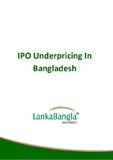| dc.contributor.advisor | Habib, Md. Mamun | |
| dc.contributor.author | Nabi, Md. Shakilun | |
| dc.date.accessioned | 2017-11-30T05:45:36Z | |
| dc.date.available | 2017-11-30T05:45:36Z | |
| dc.date.copyright | 2016 | |
| dc.date.issued | 2016-12-10 | |
| dc.identifier.other | ID 14364024 | |
| dc.identifier.uri | http://hdl.handle.net/10361/8552 | |
| dc.description | This internship report is submitted in a partial fulfilment of the requirements for the degree of Masters of Business Administration, 2016. | en_US |
| dc.description | Cataloged from PDF version of internship report. | |
| dc.description | Includes bibliographical references (page 42). | |
| dc.description.abstract | When a company or issuing firm offers to sell shares of their business to the public for the first time with the expectation to develop liquid market is called Initial Public Offering (IPO). The main reason of a company to be listed in stock exchange is raise equity capital from stock market.
When the offering price of a stock in primary market is lower than the first day closing price of that stock in secondary market then it is called IPO underpricing. Generally, the issuing firm set the offering price at a level so that the first day return in secondary market show positive. The main reason of IPO underpricing is information asymmetry. Managers of companies don’t care about their share price underpricing because they give focus on their increase of capital and higher return. Actually investment bankers make information asymmetry because they know the pros and cons of stock market very well. Based on the investment banker’s expertise and issuing firm expectation they make information asymmetry and ensure maximum amount of raising fund from primary market for issuing firm.
The main focus of this study is IPO underpricing and initial return from underpricing beside that market efficiency and effect on capital structure. Through the study it’s found that IPO underpricing is a common phenomenon in all major stock exchanges. In case of Bangladesh from 2006 to 2015, 140 IPOs are examine for the study. Through the study it found that 127 companies IPO is underpriced 12 companies IPO is overprices and only one company IPO is remain same. The percentage of IPO underpricing is 91 percent, overpricing is 8.5 percent, and .50 percent remain same. The only IPO correctly priced was EBL NRB Mutual Fund in 2011.
Maximum return was 1531 percent which was gained on Padma Islami Life Insurance which hit the market in 2012. In the year of 2010 and 2011, 14 companies are listed and among them 11 companies are underpriced. In 2007, 2009, 2013 and 2014 all the listed companies IPO is underpriced. The highest degree of underpricing recorded in 2009 with mean return 371.63 percent and standard deviation of 328.02 percent. Sector basis Pharmaceuticals sector records highest underpricing with mean return 514.21 percent with standard deviation 356.10 percent.
There are some reasons of underpricing such as the market feedback hypothesis, the bandwagon hypothesis, the investment banker’s monopoly power hypothesis, the due diligence hypothesis, the signaling hypothesis, problem of “Winner’s Curse”, the ownership dispersion hypothesis and underpricing as a dynamic strategy. Based on the overall observations it’s clear that a long time is required to overcome from the IPO underpricing. | en_US |
| dc.description.statementofresponsibility | Md. Shakilun Nabi | |
| dc.format.extent | 42 pages | |
| dc.language.iso | en | en_US |
| dc.publisher | BRAC University | en_US |
| dc.rights | BRAC University Internship reports are protected by copyright. They may be viewed from this source for any purpose, but reproduction or distribution in any format is prohibited without written permission. | |
| dc.subject | Initial public offering | en_US |
| dc.subject | Bangladesh | en_US |
| dc.title | IPO underpricing in Bangladesh | en_US |
| dc.type | Internship report | en_US |
| dc.contributor.department | BRAC Business School, BRAC University | |
| dc.description.degree | M. Business Administration | |

